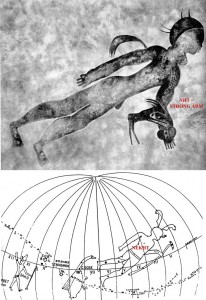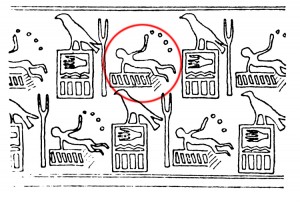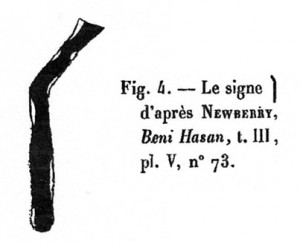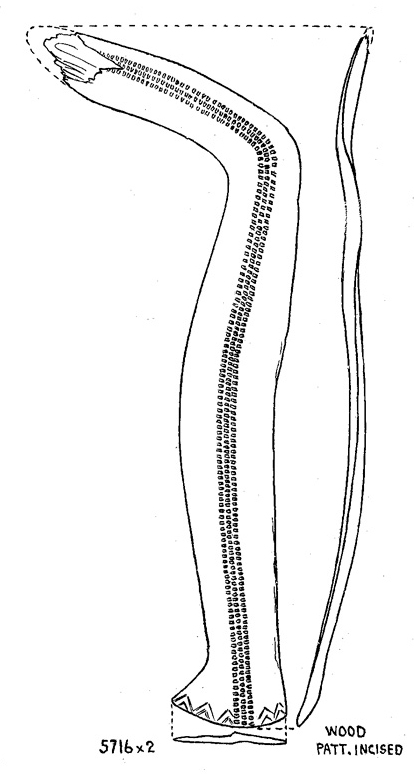Nht = Strong Arm (prehistoric rock painting)
This prehistoric rock painting, called ‘The Swimmer’, was discovered around 1956 by the French archaeologist-cum-ethnologist Henri Lhote in the Tassili-n’Ajjer-mountains in North Africa. Here, in the Central Mountains of North Africa, we find a series of prehistoric settlements. The unique rock painting is about 8,500 years old.
Around 1940, the Egyptologist Flinders Petrie reconstructed the constellations of the northern heavens (see Fig.1) by means of the Star clock of Ramesses (approx. 1,190 BCE). He observed that the arrangement of certain stars coincided with the giant constellation Neht. The meaning of Nht is ‘brave, strong, invincible’. The identical representations are striking. The typical bend of the arm on the depiction indicates the ‘Strong Arm’ (its strength is indicated by the stone that is tied to the wrist).
The Throwstick (see ‘Badarians’ below) appears as hieroglyph T15 (Egyptian Grammar, Sir Alan Gardiner, p.513). It is a weapon and very old. First, it was found in the prehistoric settlement Badari (5000-4000 BC). See the text and the picture in the book Badarians (Guy Brunton / Gertrude Caton-Thompson) below. However, the Throwstick or Club was the emblem of the land To Tehenu (Libya), the Olive-land. A very interesting article about that issue can be found in BIFAO 31 (1931), p.121-134 from Ludwig Keimer about the earlier study of Newberry. Newberry discovered a Throwstick (see fig.4 – Le signe) in a tomb of Beni Hassan.
The color of the Throwstick was “yellowish with black cloudy graining”.
In my opinion, the Throwstick or Club must be seen in combination with the ‘Strong Arm’, because the human expression is similar. So, millennia later, the martial bearing of this ‘Strong Arm’ was represented in Egypt, on the cartouches of pharaoh Djoser and Sekhemkhet – see also the right arm of the statues of pharaoh Djoser (Fig. 2a and 2b) and Khasekhemuwy. The ‘Throw-Stick’, was the symbol of the Creator. So, that symbol of the ‘Strong Arm’ was present in situ, in principle the design of the Masterplan of the Pyramid field, stretching from Abu Rawash, via Saqqara (the bend), to Dahshur.
Badarians
Throw-sticks. Pls. xxiii, 29; xxv, I, 2 These interesting objects were found lying close to the hands of a man (5716), one on the top of the other. The wood was extremely light and the surface powdery; they were treated with celluloid solution and can now be handled. The upper one was complete, except for a small portion at the top. The upper part of the lower one is missing, and was not in the grave. They were therefore old and disused when buried, or possibly “killed.” The decoration consists of three rows of little dots down the centre of the whole length, and a border of chevrons along the edge of the handle. The dots are impressed rather than carved, as if a row of beads had been hammered on to the wood. Actual specimens of throw-sticks are rare. The next in date that I know of is one from Kahun (PETRIE, Kahun, pl. ix, 30). This is of similar form, but much larger, 174 ins. long compared with the 74 ins. of ours.
The throw-stick occurs as a hieroglyph, often in combination with the alighting duck (GARDINER, Egyptian Grammar, G41 p.472); and it is frequently seen in tomb paintings of fowling scenes. On the slate palette, British Museum 20790 (CAPART, Primitive Art, p.231) the hunters seem to carry throw-sticks in addition to their other weapons. On the Predynastic decorated vases, men also apparently carry them (ibid., p.118), but the most interesting representation is on the vase from El Amrah (MACIVER, El Amrah, pl. xiv, D46) of S.D. 50, where there are two men and one woman. One man holds two small angled sticks in one hand, and the other man also seems to hold two.



